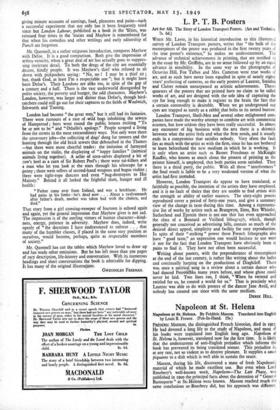L. P. T. B. Posters
WHEN Mr. Laver, in his historical introduction to this illustratrd survey of London Transport posters, writes that "the bulk of the. masterpieces of the poster was produced in the first twenty years of the true poster's existence," he makes no understatement. Th:. advance of technical achievements in printing, that are testified to in the essay by Mr. Griffiths, are in no sense followed up by an equal advance in sensibility. In the same way as the photographs of Octavius Hill, Fox Talbot and Mrs. Cameron were true works of art, and as such have never been equalled in spite of nearly eighty years' perfecting of cameras, so the early posters of Lautrec, Steinlen and Cheret remain unsurpassed as artistic achievements. Three- quarters of the posters that are printed have no claim to be called works of art, and are designed with the sole idea of capturing the rye for long enough to make it register to the brain the fact that a certain commodity is desirable. When we go underground our eyes are trapped as surely as a rabbit that bolts to its netted burrow.
London Transport, Shell-Mex and severalother enlightened com- panies have made the worthy attempt to combine art with commercial acumen, but how seldom they have been really successful. In almost any encounter of big business with the arts there is a skirmish between what the artist feels and what the firm needs, and it usually ends in a compromise that satisfies nobody. Very often the fault lies as much with the artist as with the firm, since he has not bothered to learn beforehand the new medium in which he is working. It is only when an artist such as Barnet Freedman or McKnight Kauffer, who knows as much about the process of printing as the printer himself, is employed, that both parties seem satisfied. Then there is a third party, the public. With all these " interferences " the final result is liable to be a very weakened version of what the artist had first intended.
However, London Transport do appear to have translated, as faithfully as possible, the intention of the artists they have employed, and it is no fault of theirs that they are unable to find artists with the strength or ability of earlier masters. The sixty-eight posters reproduced cover a period of forty-one years, and give a summary view of the change in taste during this time. Among a representa- tive list of works by artists such as Brangwyn, Sims, Rex Whistler, Sutherland and Epstein there is not one that has even approached the class of a Bonnard or Vuillard lithograph, which, though generally not conceived as advertising bills, contain so much of the desired direct appeal, simplicity and facility for easy reproduction. In spite of their " striking " power these French lithographs also have "good taste," an expression one would hesitate to use were it not for the fact that London Transport have obviously been at pains to find it. They have not often been successful.
Writing about posters, with the preponderance of masterpieces at the end of the last century, is rather like writing about the ballet and continually harping on the productions of Diaghileff. There was once a satirical song in a review about a certain dancer who had danced Petrorichlra many years before, and whose ghost could never be laid. Two lines ran, I think, "When he twisted and twirled for us, he created a world for us." That is precisely what Lautrec was able to do with posters of the dancer Jane Avril, and nobody has created one since with the same medium.
DEREK HILL.






































 Previous page
Previous page